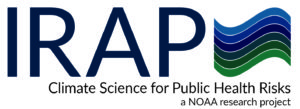This Project

Aedes-borne diseases, such as dengue and chikungunya, are responsible for more than 50-100 million infections worldwide annually, with an overall increase of 30-fold in the last 50 years, mainly due to city population growth and more frequent travel. In the case of the United States of America, the vast majority of Aedes-borne infections are imported from endemic regions by US travelers, who can become new sources of transmission once home, if the Aedes mosquitoes and suitable environmental conditions are present.
The goal of IRAP2 is to develop a monitoring and forecasting system for environmental suitability of transmission of Aedes-borne diseases for the US and the Caribbean, using innovative state-of-the-art ento-epidemiological models, climate observations, and seasonal and sub-seasonal forecasts. After detailed predictive skill assessment and validation, employing available observed information and consultation with our partners and other experts in the field, we hope to work alongside decision makers (including institutions, health policy makers, practitioners, and researchers in the US and Caribbean) to integrate this new system into decision-making frameworks.
IRAP2 Project Objectives
Objective 1. Build a consistently calibrated multi-model ensemble of climate-driven Aedes-borne disease models for application in the US and Caribbean, based on prior work undertaken by the International Research Institute for Climate and Society and the Pan American Health Organization (PAHO).
Objective 2. Integration of the monitoring and predictive approach into decision-making frameworks, via targeted interactions with institutions, health policy makers, practitioners, and researchers in the US and Caribbean.
Objective 3. Engage the public through citizen science to improve knowledge and understanding of the climate drivers of Aedes-borne diseases in the US Northeast and, through this process, add to knowledge on the northern boundary of Aedes albopictus in the region.
Our Team
The AeDES maproom is a tool produced by the International Research Institute for Climate and Society (IRI), a research institute of Columbia University in New York City. Partners for the project include the Pan American Health Organization (PAHO), the Northeast Regional Center for Excellence in Vector-Borne Diseases (NEVBD), and Ecology, Evolution, and Environmental Biology, Columbia University (E3B). Funding for this project was provided by the National Oceanic and Atmospheric Association (NOAA) under the IRAP2 project.
